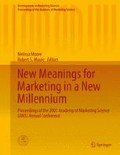Abstract
The diffusion of interactive media is fundamentally altering the concept of advertising. While interactivity stresses the importance of consumer-marketer relationships, the traditional advertising paradigm may be inadequate to guide research in an increasingly interactive context. First, traditional approaches to advertising research have implicitly assumed that advertising is something the marketer does to the consumer, downplaying the importance of the dynamic role of the consumer. Second, the role of the medium as a multidimensional element of advertising has been largely ignored. Third, a unidirectional conceptualization reduces the potential for exploring new benefits of interactive media in advertising, especially those associated with the development of collaborative relationships. Research in Information Systems (IS) has long focused on the dynamic interaction of information, technology, and users. Therefore, the study of interactive advertising can benefit from an examination of the IS literature, which provides theoretical perspectives that recognize the dynamic role of the consumer in a collaborative context, the multidimensional role of the interactive media, and the advantages arising from technology-driven consumer-marketer relationships. This paper proposes that key elements of structuration theory can supplement the extant advertising paradigm to account for consumer-marketer relationships in electronic commerce and guide research on interactive advertising. Finally, the proposed paradigm can encourage the integration of advertising, personal selling, and word-of-mouth communication into the broader marketing mix.
Access this chapter
Tax calculation will be finalised at checkout
Purchases are for personal use only
Preview
Unable to display preview. Download preview PDF.
References
Cutler, B. (1990) “The Fifth Medium,” American Demographics, 12, 24–29.
DeSanctis, G. and M. S. Poole (1994), “Capturing the Complexity in Advanced Technology Use: Adaptive Structuration Theory,” Organization Science, 5, 2, 121–147.
Giddens, A. (1984), The Constitution of Society: Outline of the Theory of Structure, University of California Press.
Glazer, R. (1989), “Marketing and the changing information environment: Implications for strategy, structure, and the marketing mix,” Report No. 89–108, Cambridge, MA: Marketing Science Institute.
Keen, Peter and Mark McDonald (2000), The eProcess Edge: Creating Customer Value and Business Wealth in the Internet Era, Osborne/McGraw-Hill, Berkeley: CA.
Kotler, P. (1986), Principles of Marketing, 3rd edition. Englewood Cliffs, N. J.: Prentice Hall.
Leckenby, J. D. and H. Li (2000), “From the Editors: Why We Need the Journal of Interactive Advertising,” Journal of Interactive Advertising, 1,1, Online: http://jiad.org/vol1/no1/editors/index.html
Lovelock, Christopher H. (1996), Services Marketing, 3rd Edition, New Jersey: Prentice Hall.
Oh, K. W., C. H. Cho, and J. D. Leckenby (1999), “A Comparative Analysis of Korean and U.S. Web Advertising,” Proceedings of the 1999 Conference of the American Academy of Advertising, 73–86.
Orlikowski, W. J. (1996), “Improvising Organizational Transformation Over Time: A Situated Change Perspective,” Information Systems Research, 7, 1, 63–86.
Pavlou, P. A. and D. W. Stewart (2000), “Measuring the Effects and Effectiveness of Interactive Advertising: A Research Agenda,” Journal of Interactive Advertising, 1, 1 (Fall). Online: http://jiad.org/vol1/no1/pavlou/index.html
Ray, M. L. (1985), "An Even More Powerful Consumer?," in Robert Buzzell (Ed.), Marketing in an Electronic Age, Cambridge, MA: Harvard University Press.
Snyder, M. and N. Cantor (1998), “Understanding personality and social behavior: A functionalist strategy,” in D. T. Gilbert, S. T. Firsk, and G. Lindzey (Eds.), The Handbook of Social Psychology, New York: Oxford University Press.
Stewart, D. W., Gary Frazier and Ingrid Martin (1996), "Integrated Channel Management: Merging the Communication and Distribution Functions of the Firm," in Esther Thorson and Jeri Moore (Eds.), Integrated Communication: Synergy of Persuasive Voices, (Hillsdale, N. J.: Erlbaum), 185–216.
Stewart, David W., Paul A. Pavlou, and Scott Ward (2001), “Media Influences on Marketing Communications,” in Jennings Bryant and Dolf Zillmann (Eds.), Media Effects: Advances in Theory and Research, Hillsdale, N. J.: Erlbaum.
Stone, M. (2000), “Web Ad Spending May Outstrip Broadcast by 2005,” Newsbytes.com, March, 28.
Webster, F. E., Jr. (1989), "It–s 1990 - Do You Know Where Your Marketing Is?," MSI White Paper, Cambridge, MA.
Author information
Authors and Affiliations
Editor information
Editors and Affiliations
Rights and permissions
Copyright information
© 2015 Academy of Marketing Science
About this paper
Cite this paper
Pavlou, P.A., Stewart, D.W. (2015). Interactive Advertising: A New Conceptual Framework Towards Integrating Elements of the Marketing Mix. In: Moore, M., Moore, R. (eds) New Meanings for Marketing in a New Millennium. Developments in Marketing Science: Proceedings of the Academy of Marketing Science. Springer, Cham. https://doi.org/10.1007/978-3-319-11927-4_68
Download citation
DOI: https://doi.org/10.1007/978-3-319-11927-4_68
Published:
Publisher Name: Springer, Cham
Print ISBN: 978-3-319-11926-7
Online ISBN: 978-3-319-11927-4
eBook Packages: Business and EconomicsBusiness and Management (R0)

